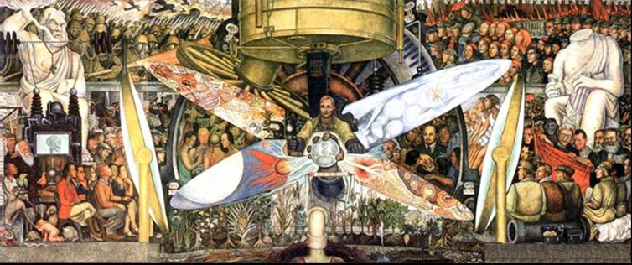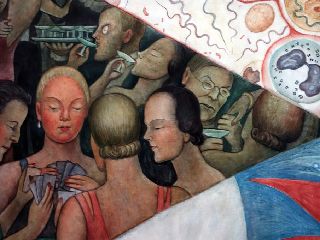More on Multiple Perspectives
Yesterday we examined Viewpoints and the Hidden Perspective, today a little more about Multiple Perspectives and Understanding an Art Work from Different Angles.
Genre artists such as Lowry and the wonderful Pieter Bruegel the Elder used multiple perspectives all the time because they were illustrating everyday life, which abounds with layers of meanings. But some portrait artists also use little twists within their images. Spend a few moments studying Johannes Vermeer’s, The Music Lesson very carefully.

Vermeer's paintings are full of symbols and layers of meanings. In The Music Lesson the woman is touching the keys of the virginal, an instrument synonymous with purity. The tutor is watching her and the woman, from first glance, is absorbed in playing the music. However, if you look in the mirror above the woman, you will see that Vermeer has painted her looking towards the tutor. This is not the angle of her head suggested by looking straight at the painting. Vermeer has altered our perception of the painting and through this, has altered our interpretation.

Some time back we looked at the Mexican artist Diego Rivera and I spoke about Nelson Rockefeller commissioning Rivera to paint a mural Man at the Crossroads for the Rockefeller Centre in New York.
Rockefeller took exception to the painting’s depiction of the Russian communist revolutionary leader Vladimir Lenin, and when Rivera refused to alter the image, Rockefeller had the mural plastered over. Rivera eventually repainted a new version of the mural and renamed it Man, Controller of the Universe and included some elements of revenge!

Under the top right hand propeller blade is Rockefeller's father. It is believed that the pattern on the propeller above his head is a dish of syphilis bacteria! Furthermore, Rivera painted Rockefeller (a teetotaller) holding a martini surrounded by women drinking, gambling and generally living it up. Oh, and Lenin was given even more prominence in the repaint, but that would have been expected from the avowed communist.

A little while ago we also took some time to look at the works of Frida Kahlo and I have included links at the end of this post. I wonder how much you remember of her life story? It will help you understand this painting titled The Bus created in 1929.

If you didn't know Frida's story you would perceive this as a delightful painting of passengers on a bus. But in 1925, at the age of 18, Frida was involved in a most horrendous accident while travelling on a bus with her then boyfriend. She sustained a broken spinal column, a broken collarbone, ribs and pelvis, 11 fractures in her right leg, a crushed and dislocated right foot, and a dislocated shoulder. Also, an iron handrail pierced her abdomen and her uterus. Over her life she had 35 surgeries on her back, right leg and foot.3
Please now return to the painting The Bus and think about how your perception of the image has changed.
Consider the message that Frida Kahlo is conveying.
Frida painted her recollection of the last moments aboard the bus before the terrible accident that robbed her of her health. She is pictured on the far right. Notice that she is not dressed in traditional Mexican costume. She adopts that exotic look later, after her 1929 marriage to flamboyant Mexican muralist Diego Rivera.3
As I write this blog I am reminded of David Malouf’s novel Fly Away Peter. This is a fabulous novel about a young man, Jim, living in rural Australia at the outbreak of World War I. The concept of the existence of multiple perspectives in our lives is explored mainly through Jim’s interest in birds.
The ground level is the flat world of individual grassblades, seen so close up that they blurred, where the ground-feeders darted about striking at worms...the long view in which all this part of the country was laid out like a relief-map in the Shire Office - surf, beach, swampland, wet paddocks, dry forested hill-slopes, jagged blue peaks.
And then Jim has the opportunity to go up in a small plane before leaving to fight in Europe. This experience gives him a bird’s eye view of the world.
He wonders whether the “map” in his own head, which he had tested and found accurate, might be related to the one the birds carried in theirs. This map allowed them to find their way “halfway across the world”. This was the true “wonder” of the world – that nature could triumph and find its way without the interference of man. As such, Jim finds the natural world more remarkable than the learning of man. Flying back, he had a “clear view of what he had already seen in imagination”.4
And to conclude - Jeffrey Smart's Portrait of Clive James is a reminder that not everyone's perception of the word portrait is the same.

Links to past posts on Frida Kahlo are given below.


Credit
- en.wikipedia.org
- lisawallerrogers.com
- fridakahlostory.com
- Malouf, David, Fly Away Peter, George Braziller (US), Chatto & Windus (UK),
1982 - artgallery.nsw.gov.au
